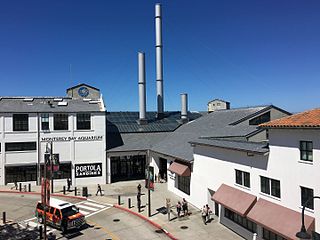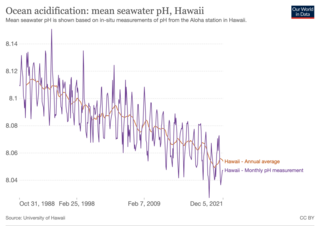Related Research Articles

Monterey Bay Aquarium is a nonprofit public aquarium in Monterey,California. Known for its regional focus on the marine habitats of Monterey Bay,it was the first to exhibit a living kelp forest when it opened in October 1984. Its biologists have pioneered the animal husbandry of jellyfish and it was the first to successfully care for and display a great white shark. The organization's research and conservation efforts also focus on sea otters,various birds,and tunas. Seafood Watch,a sustainable seafood advisory list published by the aquarium beginning in 1999,has influenced the discussion surrounding sustainable seafood.

A conventional idea of a sustainable fishery is that it is one that is harvested at a sustainable rate,where the fish population does not decline over time because of fishing practices. Sustainability in fisheries combines theoretical disciplines,such as the population dynamics of fisheries,with practical strategies,such as avoiding overfishing through techniques such as individual fishing quotas,curtailing destructive and illegal fishing practices by lobbying for appropriate law and policy,setting up protected areas,restoring collapsed fisheries,incorporating all externalities involved in harvesting marine ecosystems into fishery economics,educating stakeholders and the wider public,and developing independent certification programs.

Ocean acidification is the reduction in the pH value of the Earth’s ocean. Between 1751 and 2021,the average pH value of the ocean surface has decreased from approximately 8.25 to 8.14. The root cause of ocean acidification is carbon dioxide emissions from human activities which have led to atmospheric carbon dioxide (CO2) levels of more than 410 ppm (in 2020). The oceans absorb CO2 from the atmosphere. This leads to the formation of carbonic acid (H2CO3) which dissociates into a bicarbonate ion (HCO−3) and a hydrogen ion (H+). The free hydrogen ions (H+) decrease the pH of the ocean,therefore increasing acidity (this does not mean that seawater is acidic yet;it is still alkaline,with a pH higher than 8). A decrease in pH corresponds to a decrease in the concentration of carbonate ions,which are the main building block for calcium carbonate (CaCO3) shells and skeletons. Marine calcifying organisms,like mollusks,oysters and corals,are particularly affected by this as they rely on calcium carbonate to build shells and skeletons.
The International Arctic Science Committee (IASC) is a non-governmental organization which is composed of international science groups participating in arctic science research. IASC is an International Scientific Associate of ICSU,and was established in 1990. IASC's main aim is to initiate,develop,and coordinate leading edge scientific activity in the Arctic region,and on the role of the Arctic in the Earth system. It also provides objective and independent scientific advice to the Arctic Council and other organizations on issues of science affecting the management of the Arctic region. The decision-making organs of IASC are the Council and the Executive Committee. The day-to-day operations are supported by its secretariat headed by the executive secretary. IASC's geographical remit covers the Arctic Ocean and the surrounding landmasses.

Jane Lubchenco is an American environmental scientist and marine ecologist who teaches and conducts research at Oregon State University. Her research interests include interactions between the environment and human well-being,biodiversity,climate change,and sustainable use of oceans and the planet. From 2009 to 2013,she served as Administrator of NOAA and Under Secretary of Commerce for Oceans and Atmosphere. In February 2021,she was appointed by President Joe Biden to serve as Deputy Director for Climate and Environment in the White House Office of Science and Technology Policy.
Hopkins Marine Station is the marine laboratory of Stanford University. It is located ninety miles south of the university's main campus,in Pacific Grove,California on the Monterey Peninsula,adjacent to the Monterey Bay Aquarium. It is home to ten research laboratories and a fluctuating population of graduate and undergraduate students. It has also been used for archaeological exploration,including of the Chinese-American fishing village that existed on the site before burning down in 1906.

The environmental impact of fishing includes issues such as the availability of fish,overfishing,fisheries,and fisheries management;as well as the impact of industrial fishing on other elements of the environment,such as bycatch. These issues are part of marine conservation,and are addressed in fisheries science programs. According to a 2019 FAO report,global production of fish,crustaceans,molluscs and other aquatic animals has continued to grow and reached 172.6 million tonnes in 2017,with an increase of 4.1 percent compared with 2016. There is a growing gap between the supply of fish and demand,due in part to world population growth.

Isabella Aiona Abbott was an educator,phycologist,and ethnobotanist from Hawaii. The first native Hawaiian woman to receive a PhD in science,she became a leading expert on Pacific marine algae.
Barbara Block is an American marine biologist and Charles &Elizabeth Prothro Professor of Biology in Marine Sciences at the Stanford University Hopkins Marine Station and a co-director of Stanford University's Tuna Research and Conservation Center,with the Monterey Bay Aquarium. She has published numerous bodies of work throughout her career in marine biology and chemistry,mainly focusing on the biology and chemistry of metabolism in different tuna and shark species. Additionally,she has helped develop two new types of electronic tags for large pelagic predators in order to track the migrations of large oceanic predator species.

Antje Boetius is a German marine biologist. She is a professor of geomicrobiology at the Max Planck Institute for Marine Microbiology,University of Bremen. Boetius received the Gottfried Wilhelm Leibniz Prize in March 2009 for her study of sea bed microorganisms that affect the global climate. She is also the director of Germany's polar research hub,the Alfred Wegener Institute.
Nancy Nash Rabalais is an American marine ecologist. Born in Wichita Falls,Texas,she is the daughter of Kathryn Charlotte Preusch and Stephen Anthony Nash,a mechanical engineer,and the second of four children. She researches dead zones in the marine environment and is an expert in eutrophication and nutrient pollution.

The contributions of women in climate change have received increasing attention in the early 21st century. Feedback from women and the issues faced by women have been described as "imperative" by the United Nations and "critical" by the Population Reference Bureau. A report by the World Health Organization concluded that incorporating gender-based analysis would "provide more effective climate change mitigation and adaptation."
Stephen R. Palumbi is the Jane and Marshall Steel Jr. Professor in Marine Sciences at Stanford University at Hopkins Marine Station. He also holds a Senior Fellowship at the Stanford Woods Institute for the Environment.

Samantha "Mandy" Joye is an American oceanographer who is well known for her work studying the Deepwater Horizon Oil Spill. She is a professor at the University of Georgia in the Department of Marine Sciences. Joye has made fundamental contributions in ocean biogeochemistry and microbial ecology,and is also regularly called upon by scientific and policy agencies as well as the media for expert commentary on ocean ecology. She was the expedition scientist and a lead science advisor for The Deep episode,part of the BBC's Blue Planet II,and is featured in production videos including Brine Pools:Exploring an Alien World for Blue Planet II and Future of the Oceans. She led the “Ecosystem Impacts of Oil and Gas in the Gulf”research consortium between 2014 and 2020 and conducts research to understand relationships between biogeochemical cycles,microbial activity,and environmental factors in many diverse ocean environments.
Alexandria Boehm is an American scientist whose field of study is civil and environmental engineering. She studies sources,fate and transport of pathogens outside the human body,and coastal water quality. Boehm is a senior fellow at Stanford University's Woods Institute for the Environment and an associate professor in Stanford University's Department of Civil and Environmental Engineering.

Anne Katherine Salomon is a Canadian applied marine ecologist. She is an associate professor with the School of Resource and Environmental Management in the Faculty of Environment at Simon Fraser University. In 2019,Salomon was elected a Member of the College of New Scholars,Artists and Scientists of the Royal Society of Canada.
Christina Chemtai Hicks is a British Kenyan environmental social scientist who is a Professor in the Political Ecology group at Lancaster University. She is interested in the relationships between individuals,societies and nature. She was awarded the 2019 Philip Leverhulme Prize for Geography.
Julia Kathleen Baum is a Canadian marine biologist. In 2017,she was named to the Royal Society of Canada's College of New Scholars,Artists,and Scientists. She was awarded a Pew Fellowship in Marine Conservation in 2017 and an EWR Steacie Fellowship in 2018.
Jacqueline M. Grebmeier is an American ecologist who specializes in polar biological oceanography.

Sue E. Moore is a scientist at the University of Washington known for her research on marine mammals in the Arctic.
References
- 1 2 Shwartz, Mark (January 6, 2001). "Marine scientist Micheli uses hard science to restore fragile ocean habitats". news.stanford.edu. Retrieved April 22, 2021.
- ↑ "Dr. Fiorenza Micheli, Professor of Biological Science, Hopkins Marine Station, Stanford University". shapeoflife.org. 9 June 2017. Retrieved May 9, 2021.
- ↑ "Report of the President to the Board of Trustees". news.stanford.edu. January 5, 2000. Retrieved April 22, 2021.
- ↑ Shwartz, Mark (June 6, 2001). "Marine scientist Micheli uses hard science to restore fragile ocean habitats". news.stanford.edu. Retrieved May 9, 2021.
- ↑ Heuss, Christian (February 20, 2002). "New solutions needed to prevent extinctions and sustainably manage marine resources, scientists say". news.stanford.edu. Retrieved May 9, 2021.
- ↑ "20 scientists selected as Aldo Leopold Leadership Fellows". eurekalert.org. Eurekalert. March 16, 2004. Retrieved April 22, 2021.
- ↑ "Honors & Awards". news.stanford.edu. March 18, 2009. Retrieved May 9, 2021.
- ↑ Strain, Daniel (June 9, 2010). "A tale of two atolls: Stanford researchers study the impact of fishing on remote coral reefs". news.stanford.edu. Retrieved May 9, 2021.
- ↑ Jordan, Rob (July 30, 2014). "Stanford scientists challenge theory on protection of threatened species". news.stanford.edu. Retrieved May 9, 2021.
- ↑ "Monterey Bay National Marine Sanctuary Honors Fiorenza Micheli". hopkinsmarinestation.stanford.edu. January 25, 2017. Retrieved May 9, 2021.
- ↑ "Q&A with Fiorenza Micheli: Monitoring human rights in the seafood sector". news.stanford.edu. June 15, 2017. Retrieved May 9, 2021.
- ↑ "Micheli and Leape appointed to lead Stanford's Center for Ocean Solutions". news.stanford.edu. April 4, 2017. Retrieved May 9, 2021.
- ↑ "Professor Fiorenza Micheli confirmed as third keynote speaker IASC2019". 2019.iasc-commons.org. 2019. Retrieved May 9, 2021.
- ↑ "Fiorenza Micheli and Jeremy Goldbogen appointed as Co-Directors of Hopkins Marine Station". stanford.edu. January 15, 2021. Retrieved April 22, 2021.
- ↑ Torrent Tucker, Danielle (September 24, 2020). "New Stanford seed grants create pathways to sustainability". news.stanford.edu. Retrieved May 9, 2021.